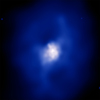of MS 0735.6+7421
Monstrous Black Hole Blast in the Core of a Galaxy Cluster

Credit: X-ray: NASA/CXC/Univ. Waterloo/B.McNamara; Optical: NASA/ESA/STScI/Univ. Waterloo/B.McNamara; Radio: NRAO/Ohio Univ./L.Birzan et al.
This is a composite image of galaxy cluster MS0735.6+7421, located about 2.6 billion light-years away in the constellation Camelopardus. The image represents three views of the region that astronomers have combined into one photograph. The optical view of the galaxy cluster, taken by the Hubble Space Telescope's Advanced Camera for Surveys in February 2006, shows dozens of galaxies bound together by gravity. Diffuse, hot gas with a temperature of nearly 50 million degrees permeates the space between the galaxies. The gas emits X-rays, seen as blue in the image taken with the Chandra X-ray Observatory in November 2003. The X-ray portion of the image shows enormous holes or cavities in the gas, each roughly 640,000 light-years in diameter -- nearly seven times the diameter of the Milky Way. The cavities are filled with charged particles gyrating around magnetic field lines and emitting radio waves shown in the red portion of image taken with the Very Large Array telescope in New Mexico in June 1993. The cavities were created by jets of charged particles ejected at nearly light speed from a supermassive black hole weighing nearly a billion times the mass of our Sun lurking in the nucleus of the bright central galaxy. The jets displaced more than one trillion solar masses worth of gas. The power required to displace the gas exceeded the power output of the Sun by nearly ten trillion times in the past 100 million years.
|
||||||||||||||||||||||||||||
The X-ray, optical, and radio image of the galaxy cluster MS 0735.6+7421 is dominated by a large, bright blue gaseous object with a small white core, with two fuzzy red streaks or jets with one reaching to the top, and one to the bottom. The blue object at the center of the image resembles a slight H shape, and has a sprinkling of yellow-white lights across and around it. This galaxy cluster is located about 2.6 billion light-years away. The optical view of the galaxy cluster, taken by the Hubble Space Telescope's Advanced Camera for Surveys in February 2006, shows dozens of galaxies bound together by gravity (yellow-white areas). Diffuse, hot gas with a temperature of nearly 50 million degrees permeates the space between the galaxies. The gas emits X-rays, colored as blue in the image taken with the Chandra X-ray Observatory in November 2003. The X-ray portion of the image shows enormous holes or cavities in the gas, each roughly 640,000 light-years in diameter -- nearly seven times the diameter of the Milky Way. The cavities are filled with charged particles gyrating around magnetic field lines and emitting radio waves shown in the red portion of image taken with the Very Large Array telescope in New Mexico in June 1993. The cavities were created by jets of charged particles ejected at nearly light speed from a supermassive black hole weighing nearly a billion times the mass of our Sun lurking in the nucleus of the bright central galaxy.




